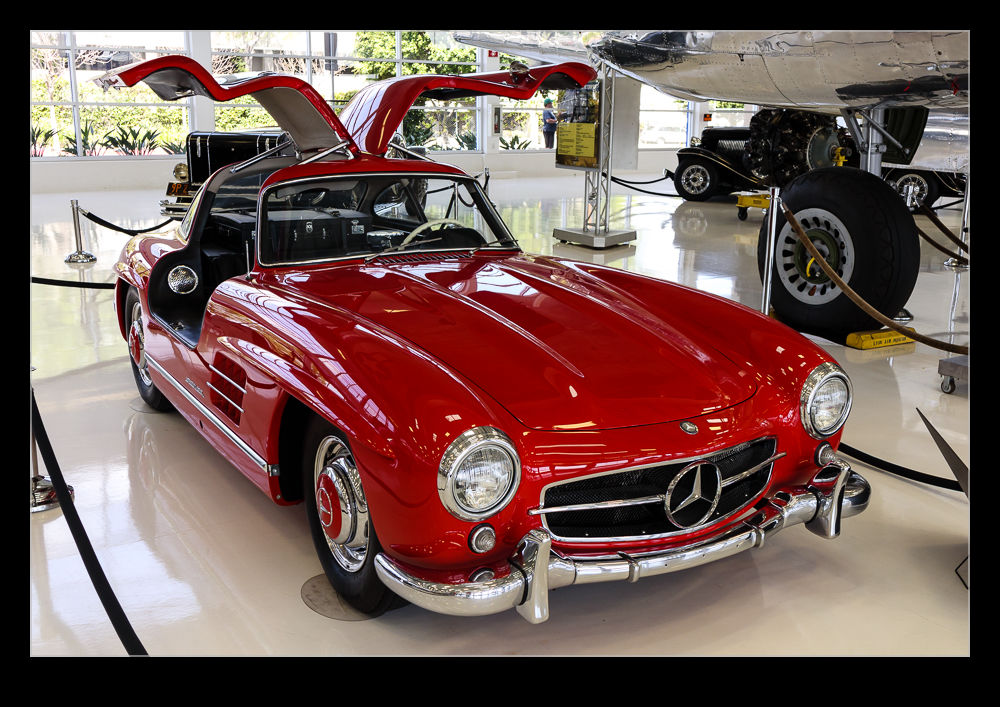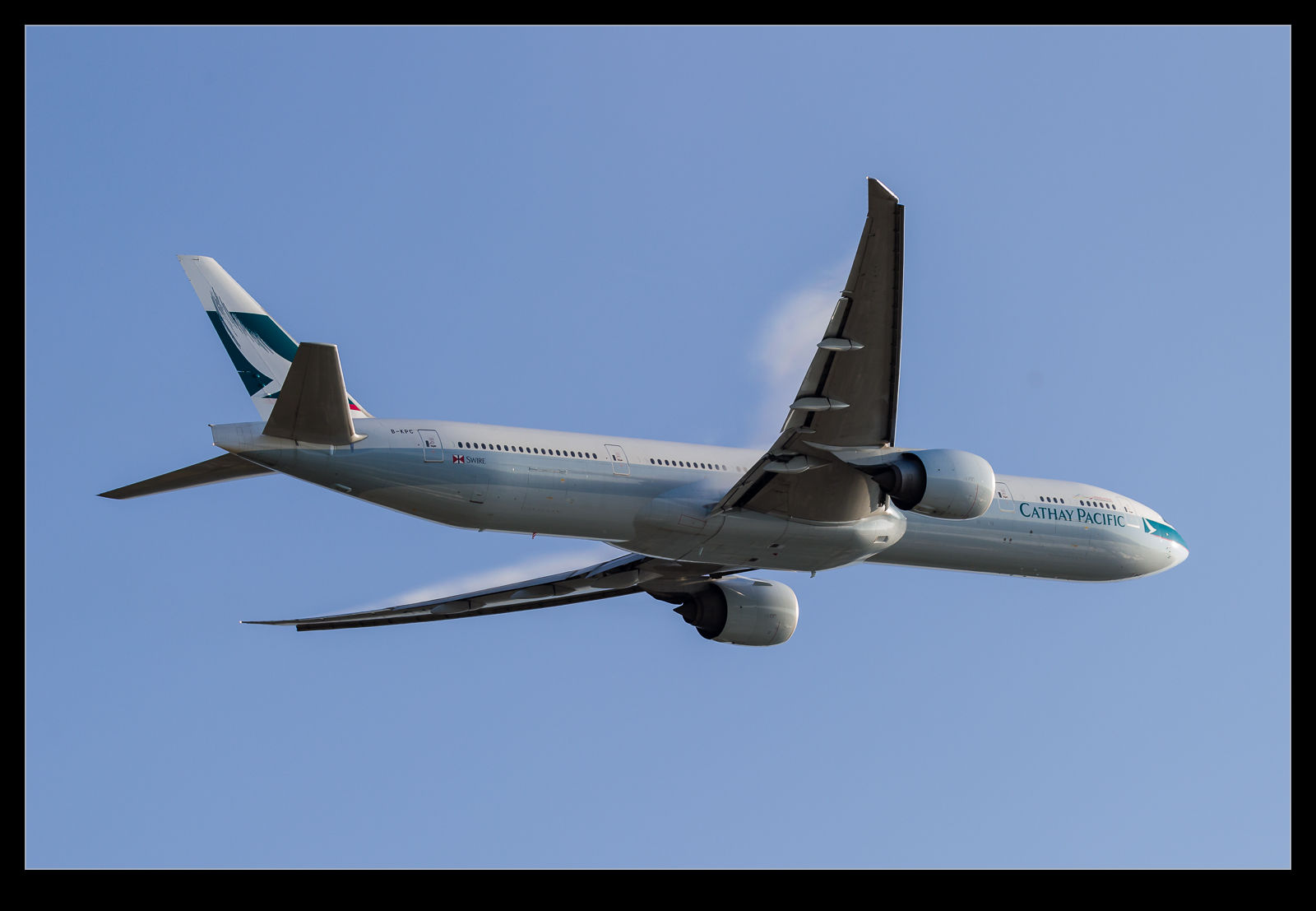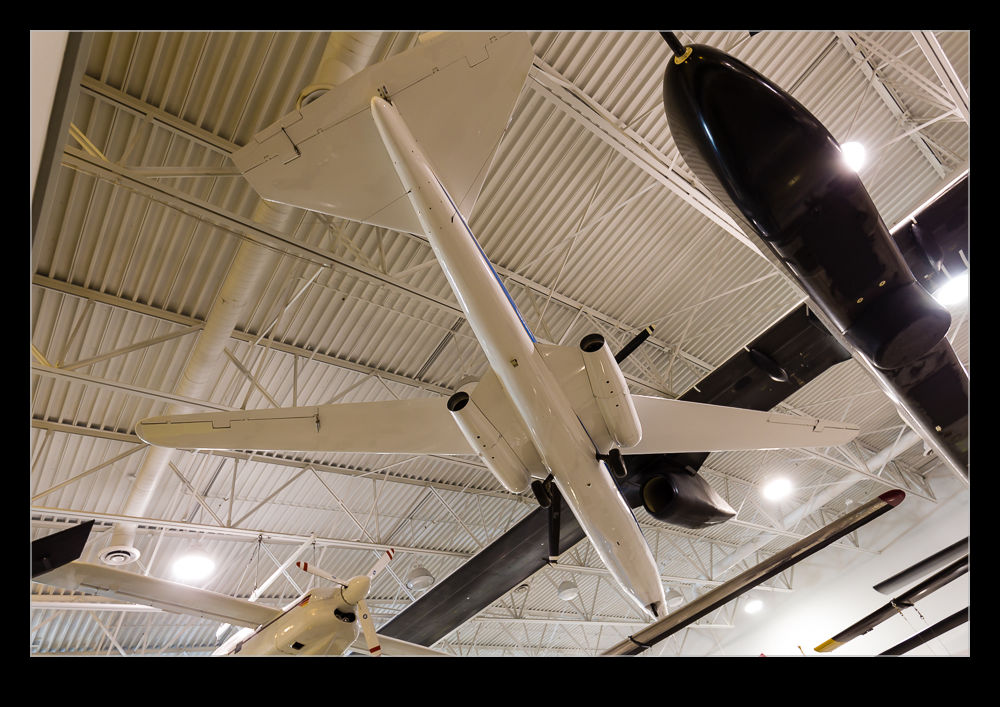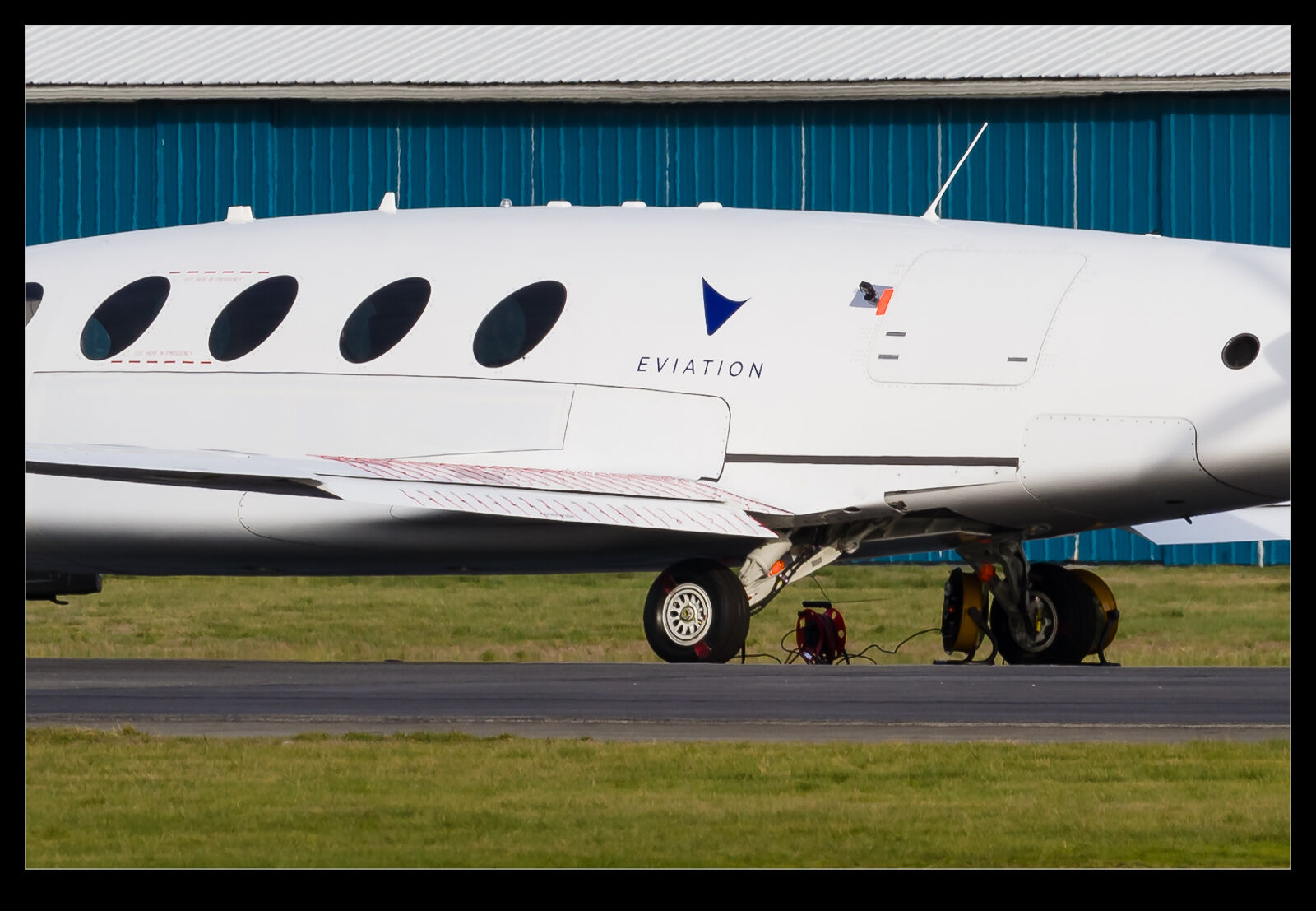 I didn’t notice this at the time but, while working my way through some shots of the Alice taxi trials, I realized that the port wing is tufted. Tufting is a simple but effective way to see how the flow is behaving on a surface. It does need to be recorded, though, so I then looked for the camera and saw the blister up on the side of the fuselage that must contain the camera. I don’t know whether they have been paying attention to the flow visualization while doing taxi trials or not. They have had flaps down as well as up but, without the nose off the ground, maybe there has not been anything significant to see. They sure aren’t saying and have other things to address after some of the testing issues.
I didn’t notice this at the time but, while working my way through some shots of the Alice taxi trials, I realized that the port wing is tufted. Tufting is a simple but effective way to see how the flow is behaving on a surface. It does need to be recorded, though, so I then looked for the camera and saw the blister up on the side of the fuselage that must contain the camera. I don’t know whether they have been paying attention to the flow visualization while doing taxi trials or not. They have had flaps down as well as up but, without the nose off the ground, maybe there has not been anything significant to see. They sure aren’t saying and have other things to address after some of the testing issues.
Tag Archives: wing
Edwards Storage Yard
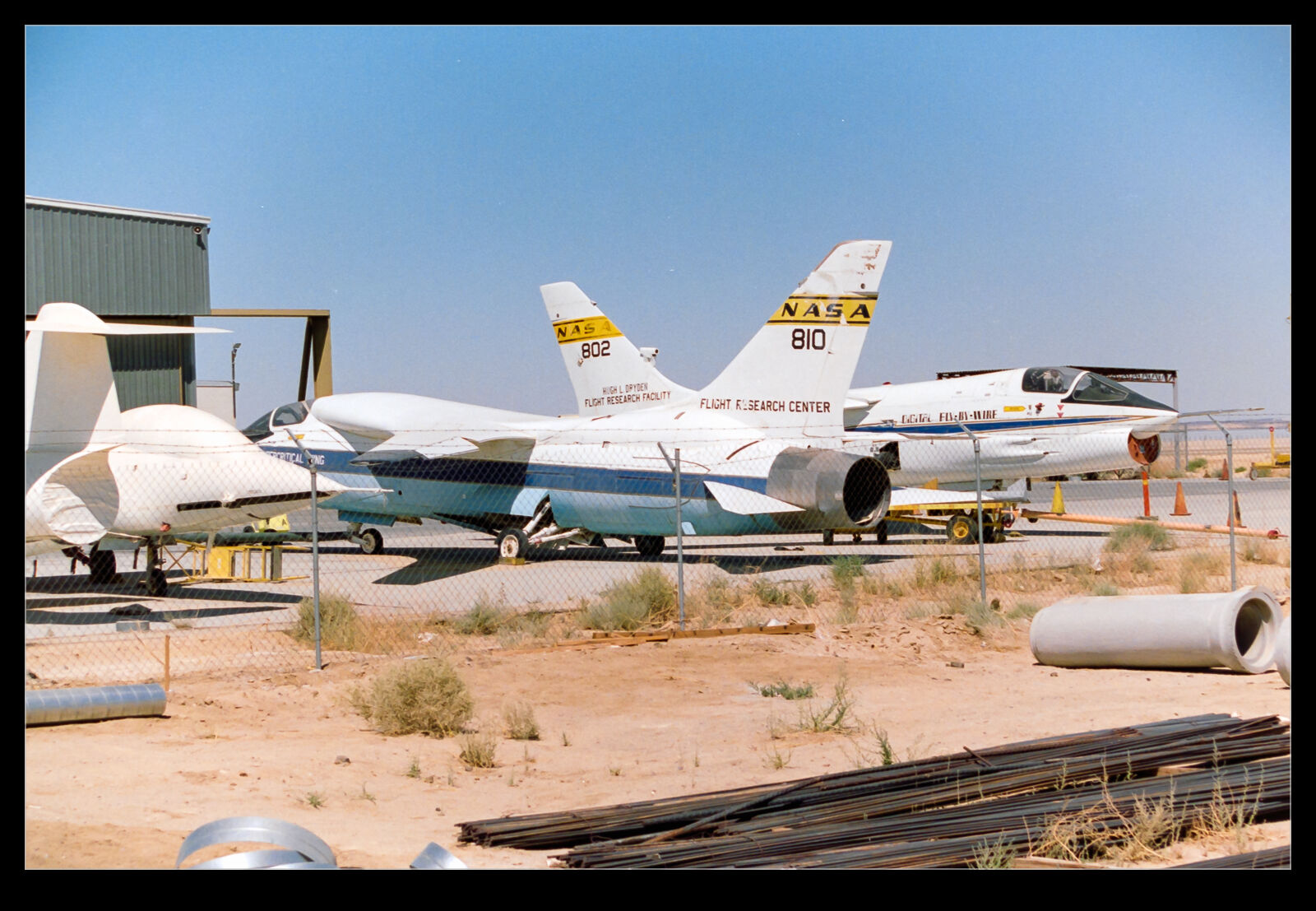 I had a recent post of some shots from the USAF museum at Edwards AFB. It reminded me of my first visit to Edwards in 1990. On that trip I saw both the USAF side of things and the NASA side. The NASA hangars were great and there were lots of amazing types being used for testing purposes. I didn’t see everything I was hoping for there but it was still fantastic. One thing that really excited me was the storage lot. There were some interesting airframes parked up there. An F-8 Crusader that had been used for supercritical wing testing was there. I think that has since been taken care of and is now restored. The fly by wire testbed was also there.
I had a recent post of some shots from the USAF museum at Edwards AFB. It reminded me of my first visit to Edwards in 1990. On that trip I saw both the USAF side of things and the NASA side. The NASA hangars were great and there were lots of amazing types being used for testing purposes. I didn’t see everything I was hoping for there but it was still fantastic. One thing that really excited me was the storage lot. There were some interesting airframes parked up there. An F-8 Crusader that had been used for supercritical wing testing was there. I think that has since been taken care of and is now restored. The fly by wire testbed was also there.
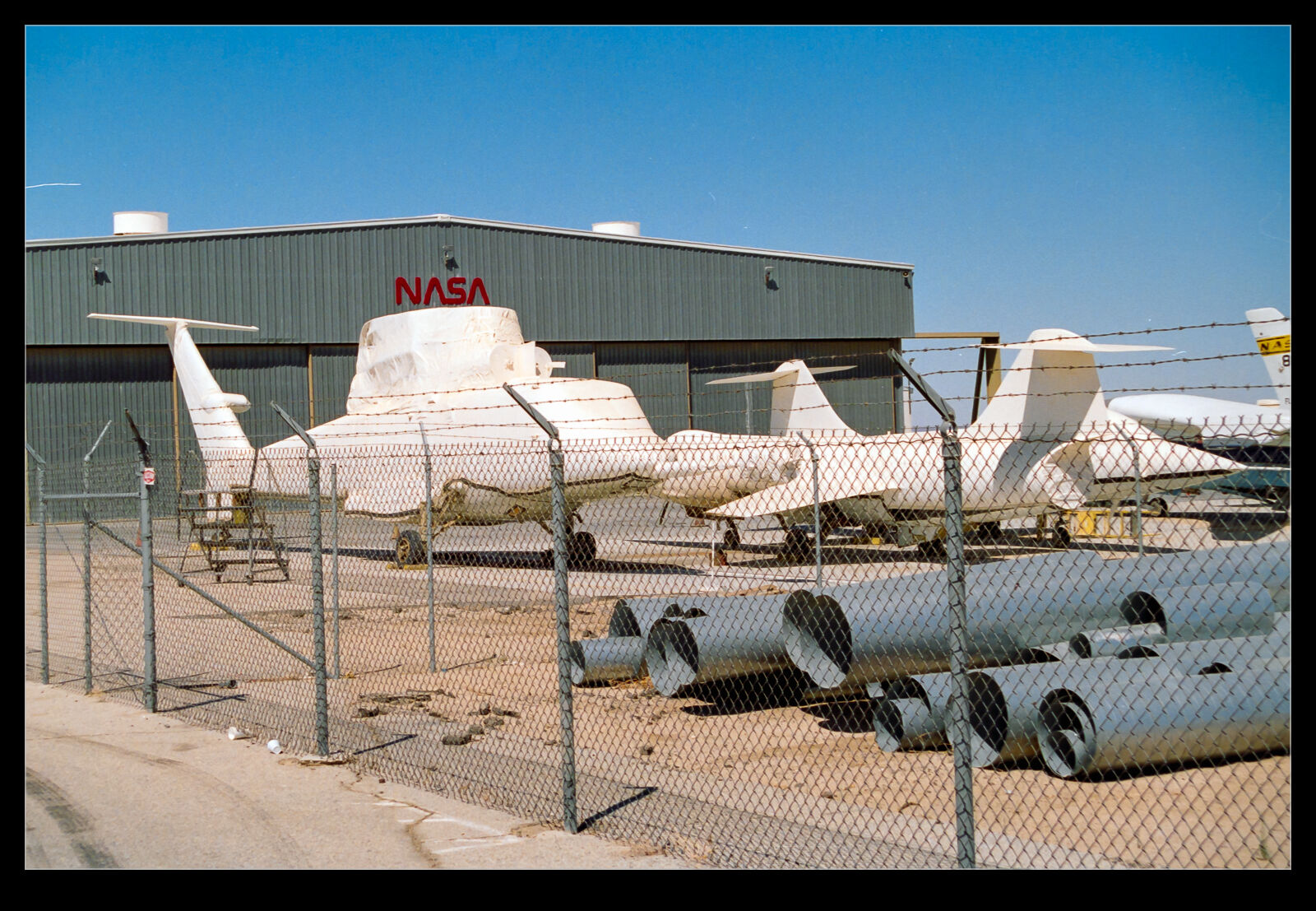 There was also a weird hybrid airframe. I think it was called RSRA which stood for rotor systems research aircraft. This was a hybrid of rotor and fixed wing technologies. One of them was modified for the X-Wing program which was canceled before it could fly. Not sure which one I saw but I think it was the unmodified one. These things could have A-10/S-3 engines fitted to them for higher speed research work. Oh, to have seen one in action. This lot would have been definitely worth some time looking around if it had been possible.
There was also a weird hybrid airframe. I think it was called RSRA which stood for rotor systems research aircraft. This was a hybrid of rotor and fixed wing technologies. One of them was modified for the X-Wing program which was canceled before it could fly. Not sure which one I saw but I think it was the unmodified one. These things could have A-10/S-3 engines fitted to them for higher speed research work. Oh, to have seen one in action. This lot would have been definitely worth some time looking around if it had been possible.
Icy Wing Mirror
 Winter frosts can produce some great patterns of ice on objects. This shot was taken of a wing mirror of a car that had grown some lovely looking ice crystals. RAW can be your friend in situations like this because the reflectivity of ice can glare detail out and RAW gives you the latitude to pull back some of the details. This was taken on the phone, but the detail survived quite well.
Winter frosts can produce some great patterns of ice on objects. This shot was taken of a wing mirror of a car that had grown some lovely looking ice crystals. RAW can be your friend in situations like this because the reflectivity of ice can glare detail out and RAW gives you the latitude to pull back some of the details. This was taken on the phone, but the detail survived quite well.
Gull Wing Mercedes
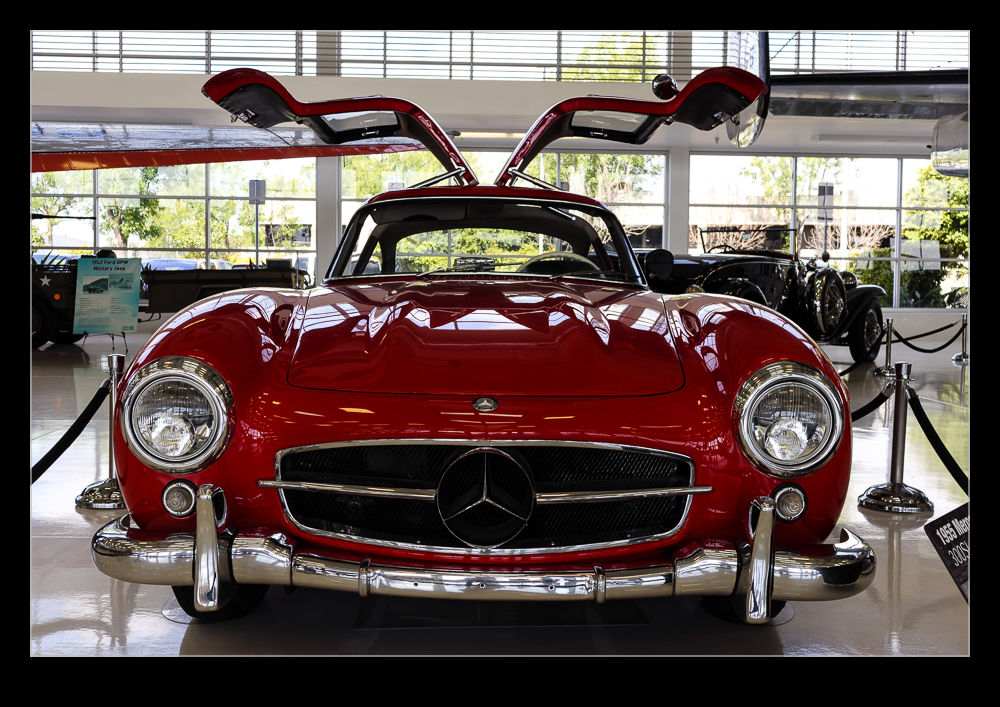 Here is one for those of you that know your vintage cars. How much is a Gull Wing Mercedes worth? This one is kept in the Lyon Air Museum in California. It seems to be in great condition and I assume it is worth quite a bit but I have no idea how much. It was tucked in amongst lots of valuable aircraft so is not the most expensive thing on display. Since the planes are generally airworthy, I would guess this is a runner too.
Here is one for those of you that know your vintage cars. How much is a Gull Wing Mercedes worth? This one is kept in the Lyon Air Museum in California. It seems to be in great condition and I assume it is worth quite a bit but I have no idea how much. It was tucked in amongst lots of valuable aircraft so is not the most expensive thing on display. Since the planes are generally airworthy, I would guess this is a runner too.
Puffs Across the Wing
The day I left London was a bit damp which made for a bit of vapor on departure. I was sitting almost directly over the wing. I couldn’t see in to the inlet but I could see vapor puffs in front of the inlet at lower speeds anyway. As we rotated and climbed out, there was plenty of vapor puffing over the upper surface, aided by climbing through a few patches of cloud. I had the video running the get a view of the moisture and here is what I got.
Inlet Vapor for the Heavies
 More shots from a fun shoot a while back. If the wind is coming from the west, evening departures from O’Hare provide plenty of opportunity to get some shots. The heavy departures to Europe leave later in the afternoon and in to the early evening and, as the sun drops down things are getting better and better. The nice thing about this day was that we got a combination of good conditions. Earlier in the afternoon, while the light wasn’t as good, a storm had not long passed through and there was plenty of moisture in the air.
More shots from a fun shoot a while back. If the wind is coming from the west, evening departures from O’Hare provide plenty of opportunity to get some shots. The heavy departures to Europe leave later in the afternoon and in to the early evening and, as the sun drops down things are getting better and better. The nice thing about this day was that we got a combination of good conditions. Earlier in the afternoon, while the light wasn’t as good, a storm had not long passed through and there was plenty of moisture in the air.
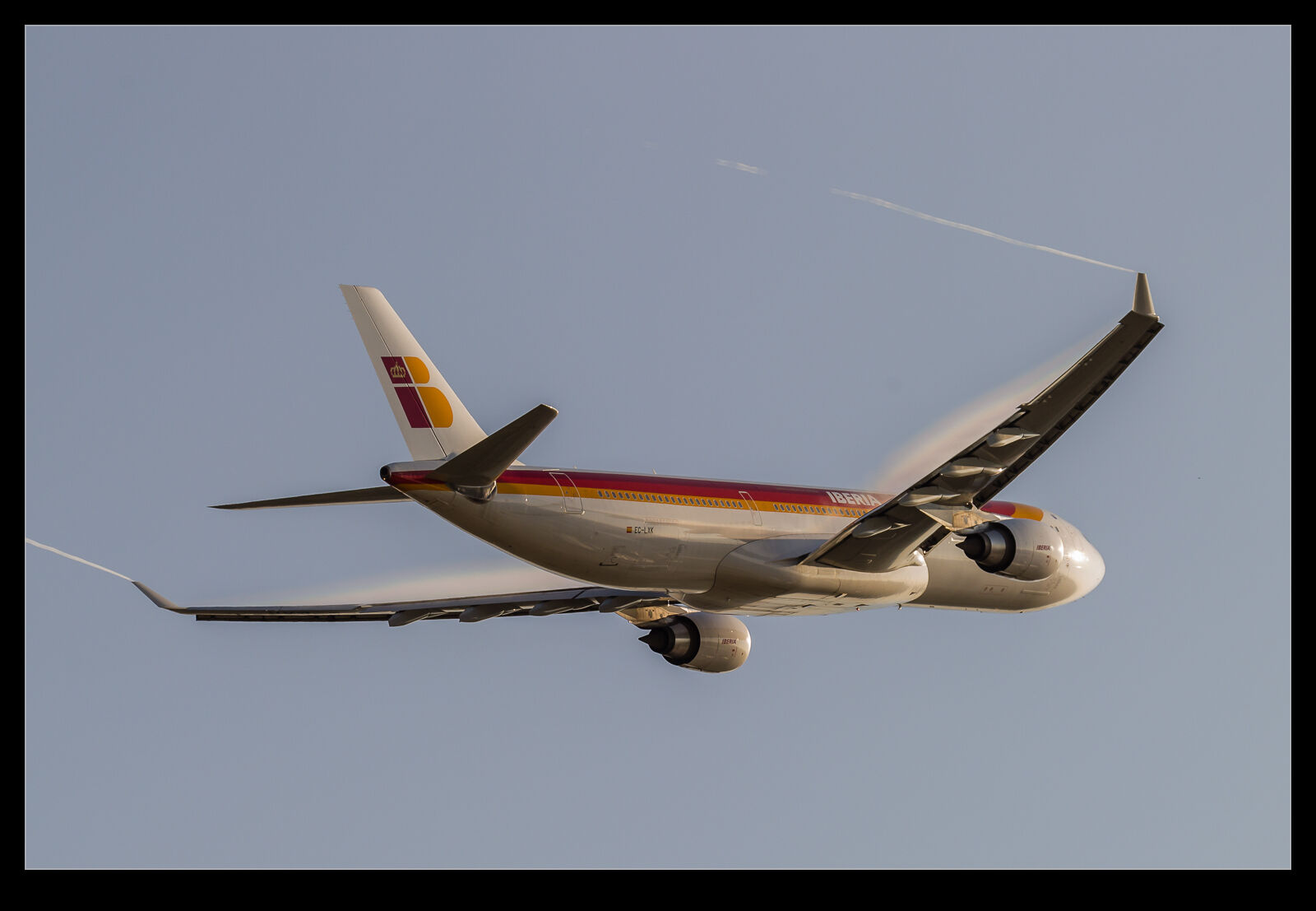 The result was a lot of vapor in the inlets of the jets as they climbed out at high thrust settings. Some of them had clouds sitting in the inlets for long periods of time. Others would just pulse with the vapor as they climbed away. They would also puff up little clouds over the upper surfaces of the wing as they fought to gain height. As the afternoon wore on, the air dried out a bit and the vapor went away. However, the light was then getting better so no reason to go just yet!
The result was a lot of vapor in the inlets of the jets as they climbed out at high thrust settings. Some of them had clouds sitting in the inlets for long periods of time. Others would just pulse with the vapor as they climbed away. They would also puff up little clouds over the upper surfaces of the wing as they fought to gain height. As the afternoon wore on, the air dried out a bit and the vapor went away. However, the light was then getting better so no reason to go just yet!
The Less Subtle Bits of Dreamliner Design
 Airliner design is a complex task with many compromises. It is not a surprise that some aspects of the design that results aren’t exactly what you would like. Today I am picking on one particular type – the Boeing 787 Dreamliner. This is almost as new as it gets in the airliner design world so you would expect it to be better than what came before. However, having seen a number of them recently, I have been focused on two areas of the design that are rather disappointing. One is the wing root fairing area and the other is the cargo doors.
Airliner design is a complex task with many compromises. It is not a surprise that some aspects of the design that results aren’t exactly what you would like. Today I am picking on one particular type – the Boeing 787 Dreamliner. This is almost as new as it gets in the airliner design world so you would expect it to be better than what came before. However, having seen a number of them recently, I have been focused on two areas of the design that are rather disappointing. One is the wing root fairing area and the other is the cargo doors.
 A nice smooth design is what the old aero guy in me likes to see and the inlets and fairings around the transition from the fuselage into the wing root are pretty ugly. They are obviously there as a result of functionality requirements but it does not look good and I imagine it comes with a drag penalty that has had to be accepted.
A nice smooth design is what the old aero guy in me likes to see and the inlets and fairings around the transition from the fuselage into the wing root are pretty ugly. They are obviously there as a result of functionality requirements but it does not look good and I imagine it comes with a drag penalty that has had to be accepted.
 The other area is the cargo doors. I am not sure whether this is a function of the load transfer requirements from composite to metal in the hinges but this area looks rather chunky and draggy. I know from previous projects that the nature of composites versus metals means that you can end up with some large joining fixtures to redistribute the loads but there may be other reasons I haven’t thought about. Given how smooth some metallic fuselage cargo doors are, these jumped out at me. Perhaps I have never looked closely enough at other types. Whatever the fairness of it, I just don’t like what they have done here.
The other area is the cargo doors. I am not sure whether this is a function of the load transfer requirements from composite to metal in the hinges but this area looks rather chunky and draggy. I know from previous projects that the nature of composites versus metals means that you can end up with some large joining fixtures to redistribute the loads but there may be other reasons I haven’t thought about. Given how smooth some metallic fuselage cargo doors are, these jumped out at me. Perhaps I have never looked closely enough at other types. Whatever the fairness of it, I just don’t like what they have done here.
Sailing with a Wing
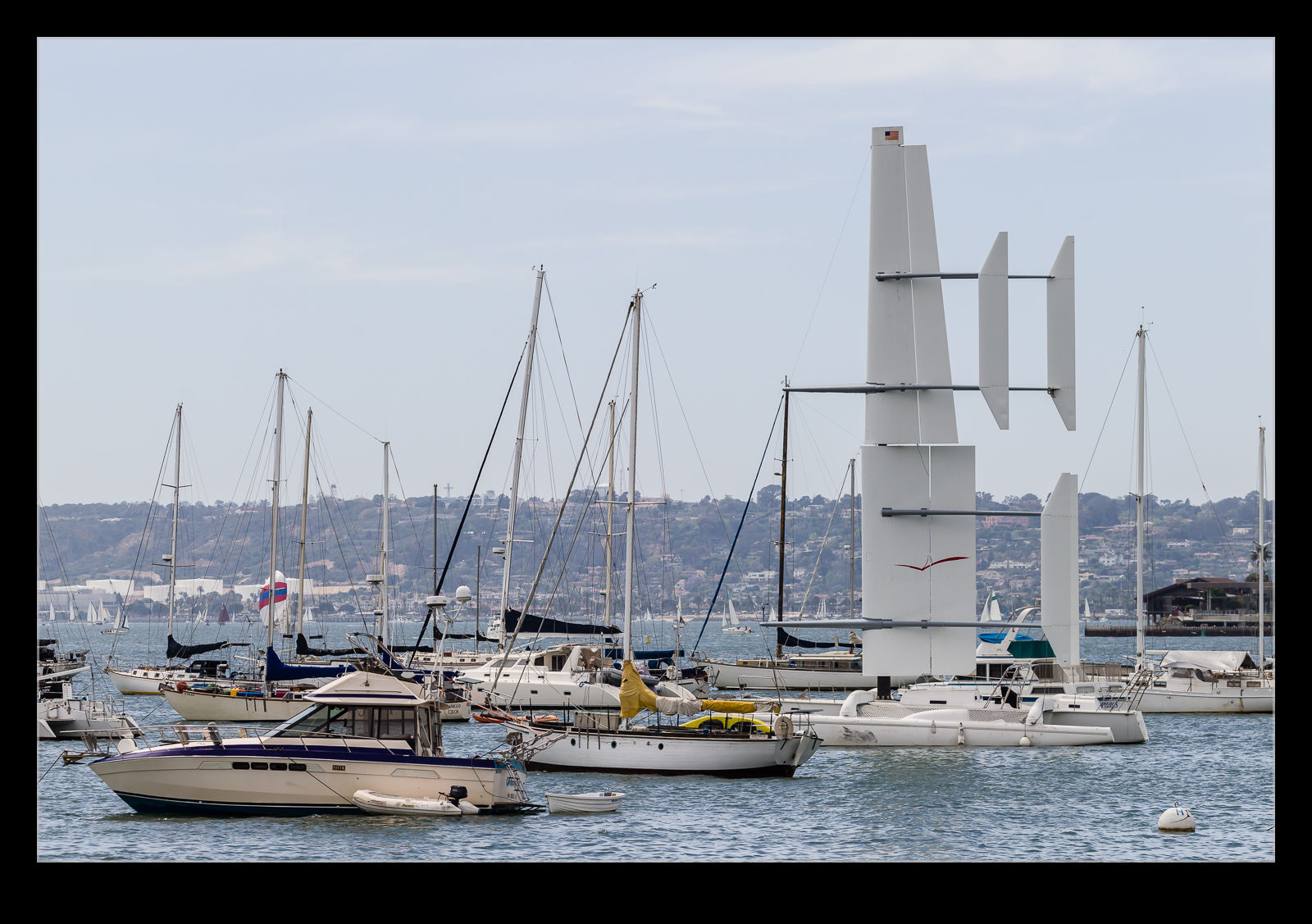 As we were driving along the harbor in San Diego, I saw something odd in the marina area. We doubled back and found somewhere to park so I could investigate further. It was a sailing boat which had an airfoil style of mast as opposed to a normal mast with rigging for sails. The wing section appeared to be in multiple parts which, I imagine, would provide a greater degree of control. Since the boat was moored, we didn’t see it in action so I have no idea how well it performs but it certainly looked pretty interesting.
As we were driving along the harbor in San Diego, I saw something odd in the marina area. We doubled back and found somewhere to park so I could investigate further. It was a sailing boat which had an airfoil style of mast as opposed to a normal mast with rigging for sails. The wing section appeared to be in multiple parts which, I imagine, would provide a greater degree of control. Since the boat was moored, we didn’t see it in action so I have no idea how well it performs but it certainly looked pretty interesting.
Oblique Wing
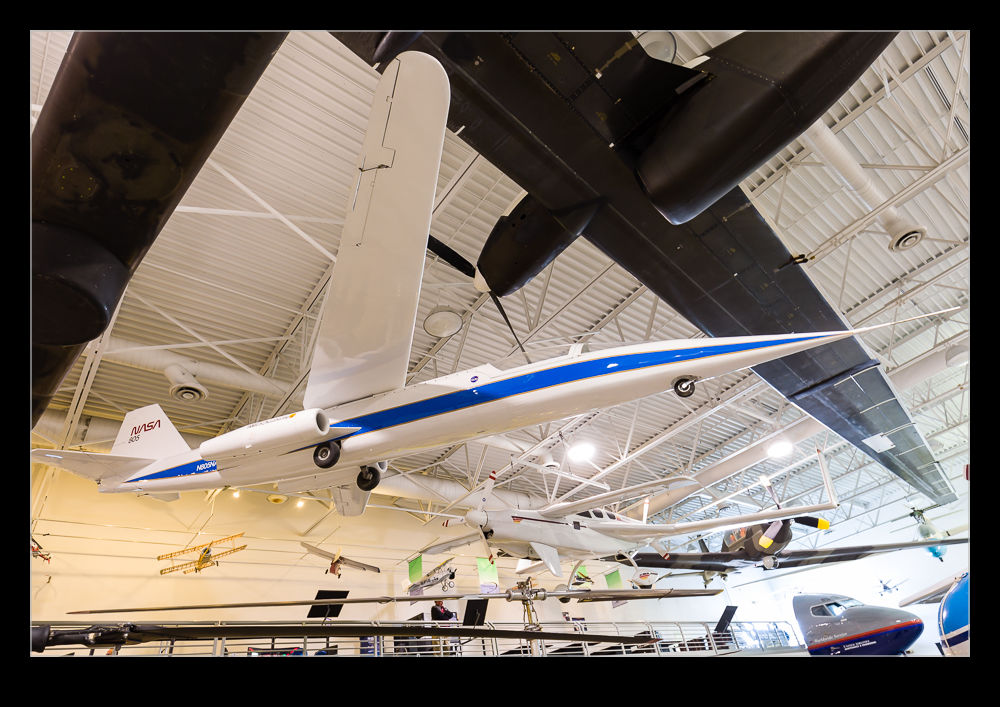 Hiller Aviation Museum has another aircraft I find interesting. This is the AD-1 Oblique Wing research aircraft from NASA. I have crossed paths with this machine before. I have seen it at Hiller before but it was also still at Edwards when I paid a visit to the NASA facility there in 1990. The oblique wing concept is an interesting one. Swing wing aircraft aim to combine he low speed and high speed characteristics required into one plane by having multiple wing sweep angles. The oblique wing approach aims to simplify this by having a single wing that pivots. The sweep angle is the same but eh CG is unaffected and the pivot mechanism much simpler.
Hiller Aviation Museum has another aircraft I find interesting. This is the AD-1 Oblique Wing research aircraft from NASA. I have crossed paths with this machine before. I have seen it at Hiller before but it was also still at Edwards when I paid a visit to the NASA facility there in 1990. The oblique wing concept is an interesting one. Swing wing aircraft aim to combine he low speed and high speed characteristics required into one plane by having multiple wing sweep angles. The oblique wing approach aims to simplify this by having a single wing that pivots. The sweep angle is the same but eh CG is unaffected and the pivot mechanism much simpler.
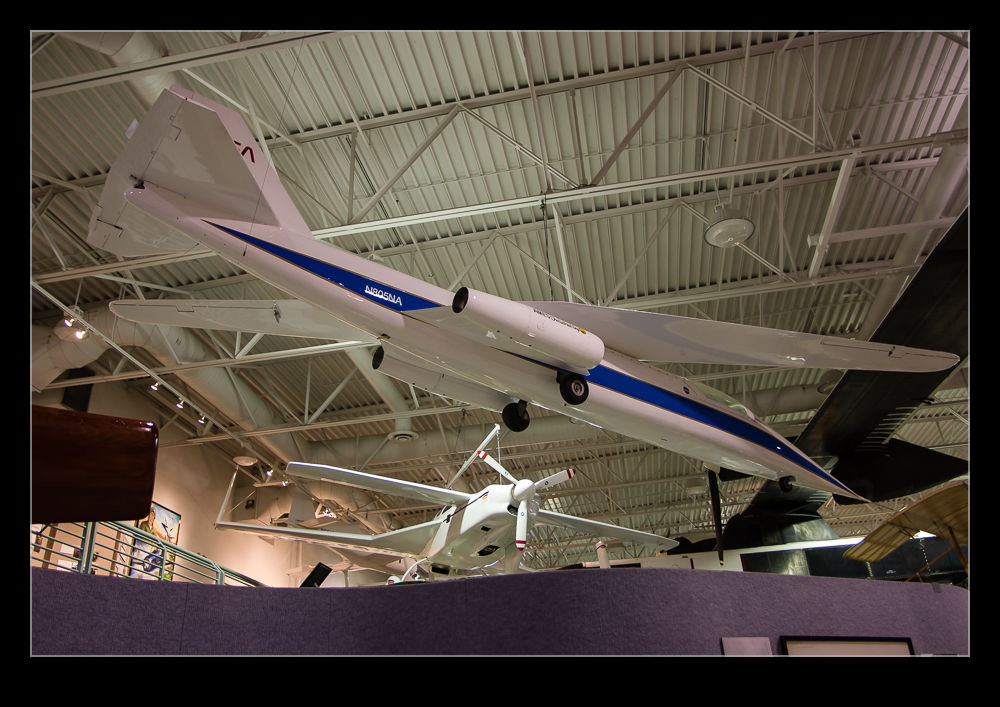 Forward swept wings are fine so, while the oblique wing looks odd, it should be practical. It will have some interesting aeroelastic issues to be dealt with but, it should be possible to engineer. Whether it will then deliver the benefits has never been tested. The AD-1 was a low speed research aircraft only but it flew many times over the years it was in service. Now it hangs from the roof of the museum.
Forward swept wings are fine so, while the oblique wing looks odd, it should be practical. It will have some interesting aeroelastic issues to be dealt with but, it should be possible to engineer. Whether it will then deliver the benefits has never been tested. The AD-1 was a low speed research aircraft only but it flew many times over the years it was in service. Now it hangs from the roof of the museum.


